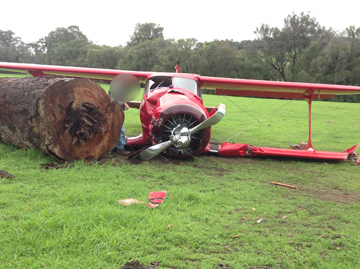
On 31 May 2014 at about 1322 Western Standard Time, a Beech Aircraft Corp D17-S, was being used to conduct a private flight from Crooked Brook landing area to Geraldton airport, Western Australia. The flight was conducted in visual meteorological conditions and the pilot was the only person on board.
After departure, the pilot tracked FNS in a northerly direction and climbed to an altitude of about 2,500 feet above mean sea level (AMSL). About a minute after setting the engine to cruise power, the pilot felt a violent vibration with an associated decrease in engine power. The pilot described the engine as ‘surging’ and ‘back-firing’. The pilot conducted initial troubleshooting and was unable to identify a reason for the engine malfunction. The vibration ceased and the engine was no longer producing power but the propeller was windmilling. The pilot elected to leave the landing gear retracted and set up a glide approach tracking to the north-east to locate a more suitable landing area to conduct a forced landing. A suitable paddock was identified that was near a house. The aircraft flew over a line of tall trees and then clipped a fence that was next to a private road leading to the house, went through a second fence on the other side of the road, which partially arrested the aircraft. It then impacted a large log and came to rest. A passer-by assisted the pilot to evacuate the aircraft. The pilot was seriously injured and transported to hospital and the aircraft was substantially damaged.
This accident is a timely reminder for pilots to consider the effect an in-flight engine failure at different altitudes has on the time available to manage that failure and identify a suitable forced landing area.
The pilot reported that he had conducted a pre-take-off brief covering the actions and considerations in relation to an engine failure. The pilot also indicated that he had flight planned to cruise at an altitude of 4,500 feet AMSL but amended this to 2,500 feet AMSL due to the increase in wind speed at altitude.
The pilot reported that the engine was subsequently examined and that a hole was located in the number five cylinder wall. Extensive internal damage was found and the reason for the internal engine failure could not be determined. The pilot indicated that the engine had failed at about 223 hours since it was last overhauled and that the specified time between engine overhauls was 1,000 hours.
Safety message
Pilots should consider the effect an in-flight engine failure at different altitudes has on the time available to manage that failure and identify a suitable forced landing area. In this instance the pilot had enough time to manoeuvre towards a different area.
The ATSB booklet Avoidable Accidents No. 3 - Managing partial power loss after take-off in single-engine aircraft contains information that is also relevant to a complete engine power loss.
The booklet highlights the importance of:
- pre-flight decision making and planning for emergencies and abnormal situations for the particular aerodrome including a thorough pre-flight self-brief covering the different emergency scenarios.
- conducting a thorough pre-flight and engine ground run to identify any issues that may lead to an engine failure.
- taking positive action and maintaining aircraft control either when turning back to the aerodrome or conducting a forced landing until on the ground, while being aware of flare energy and aircraft stall speeds.
Read the final report: Engine failure involving a Beech Aircraft Corp D17-S, VH-FNS, 12 km east-south-east of Bunbury Airport, Western Australia, on 31 May 2014


